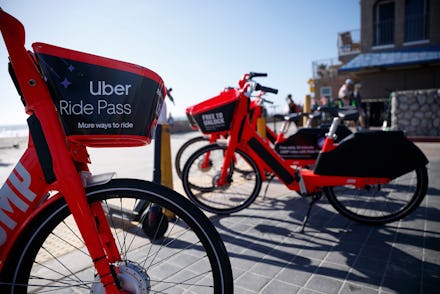Uber is testing a subscription service that bundles rides, Eats, and bikes

Uber Bike, Uber Eats, and Uber rides — Uber is trying to set itself up to be an all-in-one, on-demand service that people won't hesitate to rely on for daily tasks. Now, the company is testing out a subscription plan that will bundle its major ride-sharing and food delivery services for a simple, monthly fee. Currently available in San Francisco and Chicago, the new Uber subscription plan offers free Uber Eats delivery, discounted Uber rides, and free Uber Bike rentals.
The discounted ride prices appear similar to the Ride Pass program that's already available in certain cities, and offers riders protection from surge pricing or any other price increases that can occur due to traffic, the time of day, or weather.
For the entire package, the subscription costs $24.99 a month. Uber's direct competitor, Lyft, also offers a similar monthly subscription at $299 a month for 30 rides under $15. If a rider goes on a trip that's over $15, they must pay the difference. Lyft's plan, called All-Access, is a little more complicated with its price restriction and doesn't include food delivery. The All-Access plan doesn't appear to include Lyft's bikes and scooters, either.
According to Vox, the two ride-hailing companies have each been planning a subscription service since 2017 to keep customers from switching services whenever they please. It isn't a well-kept secret to know that many riders use both services — in addition to traditional taxis — and hop between the two to fiddle around with the best pricing they can find. With a subscription service that offers consistently discounted rates, Uber can encourage brand loyalty — people might end up sticking with the company despite Lyft's offerings since Uber subscribers will feel like they've already paid, in-part, for it.
With steep competition in the food delivery field (Grubhub, Postmates) and the bike or scooter rental industry (Bird), Uber is facing more pressure than ever to keep customers locked into using its services. The competition is motivating the company to develop and test more offerings in other crowded industries. Uber has been known to dabble in self-driving vehicles, a factoid that comes up often as human drivers continue to fight for better pay. A lesser known service, Uber Freight, directly competes with other truckers to match businesses with available carriers.
Uber has also continued to add to their list of services by offering helicopter flights to heavy users through Uber Elevate, Quiet Mode for riders who aren't interested in conversation, and even bonuses for shopping that can go towards Uber trips.
All this dabbling comes for a reason: The company is spilling money every year as Uber continues to operate at a loss. Lyft struggles with the same problem — an issue that appears inherent to the variable pricing of the ride-sharing model — and both companies seem determined to fix the bleeding before too much damage has been done.
For now, Wall Street and other investors are hopeful for Uber and Lyft's future. According to The New York Times, Uber was valued at $82.4 billion when it opened to the public in May. In contrast, Reuters reported Lyft valuing at $24.3 billion during its first public offering in March. The company's share has since fallen — Lyft reported a $1.14 billion loss during its first quarter by the time Uber entered the market — and Uber's shares have also fluctuated since their IPO.
The good news for Uber loyalists is that, if this subscription plan works out, riders could expect additional services gradually bundled into the plan. It wouldn't be a wild idea to imagine Uber offering a 'high-tier' plan for power users, businesses, and helicopter riders.
At this time, the subscription is only available to users in Chicago and San Francisco. The company plans to expand the service to other locations, though there has yet to be firm dates given.